Stock Market On Target for Retest of January Lows
Stock-Markets / US Stock Markets Mar 02, 2008 - 10:38 AM GMTBy: Mike_Burk
The good news is: We will probably see a multi month low in the next few weeks.
Short Term After a bottom has been reached downside volume diminishes quickly.
The chart below is an update of one from last week that covers the past 9 months showing the NASDAQ composite (OTC) in blue and a 5% trend (39 day EMA) of NASDAQ downside volume (OTC DV) in black. OTC DV has been plotted on an inverted Y axis so decreasing OTC DV moves the indicator upward (up is good).
There was a sharp decrease in OTC DV after the August low, but not following the January low suggesting there will be more downside movement.
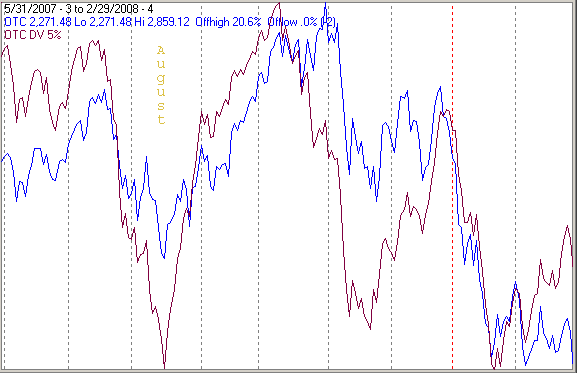
Intermediate Term
New lows offer the best bottom indicator.
When a bottom has been reached new lows diminish rapidly.
When there has been an extreme number of new lows (anything above 400 on the NASDAQ) there is usually a retest. Near the August low there were 480 new lows on the NASDAQ, near the January low there were 877. Either number suggests a retest.
The NASDAQ composite (OTC) hit a new cycle low last Friday and there were "only" 164 new lows. Unless there is a large build up of new lows in the next few weeks the market should be near its low for this cycle.
The chart below covers the past year showing the OTC in blue and a 10% trend (19 day EMA) of NASDAQ new lows (OTC NL) in red. Like OTC DV in the chart above OTC NL has been plotted on an inverted Y axis so decreasing new lows move the indicator upward (up is good).
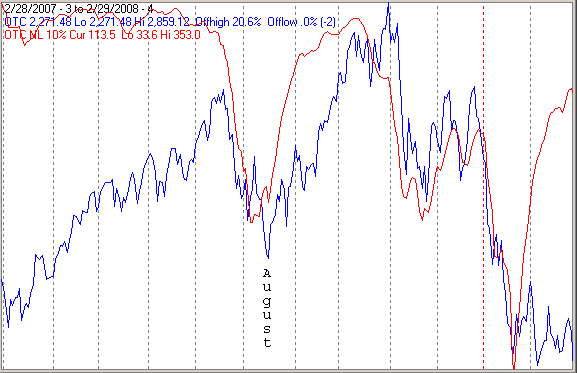
The next chart is similar to the one above except it covers the past 8 years from March 1, 2000 through last Friday. Dashed vertical lines have been drawn on the 1st trading day of each year.
OTC NL hit its lowest point of the past 8 years last January.
During the 2000 - 2002 bear market OTC NL hit its lowest low in early 2001, a higher low in late 2001 and another higher low in late 2002 when prices made their final low.
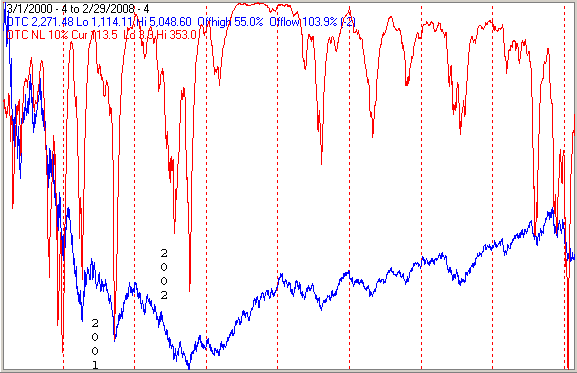
Seasonality
Next week includes the first 5 trading days of March during the 4th year of the Presidential Cycle.
The tables show the daily change of the OTC and S&P 500 (SPX) for the first 5 trading days of March during the 4th year of the Presidential Cycle. OTC data covers the period from 1964 - 2004 and SPX data from 1928 - 2004. There are summaries for both the 4th year of the Presidential Cycle and all years combined.
Historically the secondaries have had a negative seasonal bias over the coming week during the 4th year of the Presidential Cycle. By all other seasonal measures the week has been modestly positive.
Report for the first 5 days of March.
The number following the year represents its position in the presidential cycle.
The number following the daily return represents the day of the week;
1 = Monday, 2 = Tuesday etc.
| OTC Presidential Year 4 | ||||||
| Day 1 | Day2 | Day3 | Day4 | Day5 | Totals | |
| 1964-4 | 0.56% 1 | -0.05% 2 | 0.13% 3 | 0.00% 4 | 0.32% 5 | 0.97% |
| 1968-4 | -0.94% 5 | -0.63% 1 | 0.59% 2 | -3.92% 3 | 1.27% 4 | -3.62% |
| 1972-4 | 0.73% 3 | 0.23% 4 | 0.48% 5 | 0.54% 1 | -0.04% 2 | 1.94% |
| 1976-4 | -0.01% 1 | 0.32% 2 | -0.41% 3 | -0.58% 4 | -0.20% 5 | -0.88% |
| 1980-4 | -0.73% 1 | -0.96% 2 | -1.56% 3 | -2.81% 4 | -1.65% 5 | -7.71% |
| 1984-4 | 0.37% 4 | 0.80% 5 | -0.66% 1 | -0.64% 2 | -1.22% 3 | -1.34% |
| Avg | -0.12% | -0.05% | -0.31% | -1.48% | -0.37% | -2.32% |
| 1988-4 | 0.10% 2 | 0.83% 3 | 0.44% 4 | 0.36% 5 | 0.32% 1 | 2.05% |
| 1992-4 | 0.32% 1 | -0.19% 2 | -0.62% 3 | -1.32% 4 | -0.97% 5 | -2.79% |
| 1996-4 | -1.27% 5 | -0.11% 1 | 1.10% 2 | -0.46% 3 | 0.12% 4 | -0.62% |
| 2000-4 | 1.86% 3 | -0.62% 4 | 3.37% 5 | -0.20% 1 | -1.16% 2 | 3.25% |
| 2004-4 | 1.38% 1 | -0.88% 2 | -0.31% 3 | 1.07% 4 | -0.36% 5 | 0.89% |
| Avg | 0.48% | -0.19% | 0.80% | -0.11% | -0.41% | 0.56% |
| OTC summary for Presidential Year 4 1964 - 2004 | ||||||
| Averages | 0.21% | -0.11% | 0.23% | -0.72% | -0.33% | -0.72% |
| % Winners | 64% | 36% | 55% | 27% | 36% | 45% |
| MDD 3/7/1980 7.49% -- 3/6/1968 4.86% -- 3/6/1992 3.07% | ||||||
| OTC summary for all years 1963 - 2007 | ||||||
| Averages | 0.30% | -0.01% | 0.28% | -0.02% | -0.03% | 0.51% |
| % Winners | 66% | 49% | 69% | 59% | 52% | 64% |
| MDD 3/7/1980 7.49% -- 3/6/1968 4.86% -- 3/5/1982 3.43% | ||||||
| SPX Presidential Year 4 | ||||||
| Day 1 | Day2 | Day3 | Day4 | Day5 | Totals | |
| 1928-4 | 0.23% 4 | 0.00% 5 | 0.69% 6 | 0.86% 1 | 0.57% 2 | 2.36% |
| 1932-4 | 0.72% 2 | 4.31% 3 | 0.00% 4 | 0.11% 5 | 2.98% 6 | 8.13% |
| 1936-4 | 1.51% 1 | 1.42% 2 | 0.27% 3 | 0.13% 4 | 0.40% 5 | 3.73% |
| 1940-4 | -0.58% 5 | 0.17% 6 | 0.08% 1 | 0.50% 2 | 0.74% 3 | 0.91% |
| 1944-4 | 0.42% 3 | 0.08% 4 | 0.17% 5 | 0.00% 6 | 0.25% 1 | 0.93% |
| Avg | 0.46% | 1.20% | 0.24% | 0.32% | 0.99% | 3.21% |
| 1948-4 | 0.50% 1 | 0.64% 2 | 0.07% 3 | -0.64% 4 | 0.21% 5 | 0.79% |
| 1952-4 | 0.09% 6 | 0.04% 1 | 1.67% 2 | 0.13% 3 | -0.08% 4 | 1.85% |
| 1956-4 | 0.44% 4 | 0.59% 5 | 0.55% 1 | -0.04% 2 | -0.07% 3 | 1.47% |
| 1960-4 | -0.20% 2 | -0.70% 3 | -1.51% 4 | -0.38% 5 | -1.01% 1 | -3.79% |
| 1964-4 | 0.22% 1 | 0.32% 2 | -0.19% 3 | -0.01% 4 | 0.32% 5 | 0.65% |
| Avg | 0.21% | 0.18% | 0.12% | -0.19% | -0.12% | 0.19% |
| 1968-4 | -0.28% 5 | -1.34% 1 | -0.23% 2 | 1.76% 3 | -0.18% 4 | -0.27% |
| 1972-4 | 0.73% 3 | -0.03% 4 | 0.58% 5 | 0.77% 1 | 0.09% 2 | 2.14% |
| 1976-4 | 0.31% 1 | 0.54% 2 | -0.58% 3 | -1.06% 4 | 0.19% 5 | -0.59% |
| 1980-4 | -1.02% 1 | 0.25% 2 | -1.46% 3 | -2.23% 4 | -1.61% 5 | -6.08% |
| 1984-4 | 0.72% 4 | 0.66% 5 | -0.85% 1 | -1.04% 2 | -1.08% 3 | -1.58% |
| Avg | 0.09% | 0.02% | -0.51% | -0.36% | -0.52% | -1.27% |
| 1988-4 | -0.22% 2 | 0.28% 3 | -0.04% 4 | -0.22% 5 | 0.03% 1 | -0.16% |
| 1992-4 | -0.06% 1 | 0.10% 2 | -0.85% 3 | -0.69% 4 | -0.51% 5 | -2.01% |
| 1996-4 | 0.62% 5 | 1.00% 1 | 0.77% 2 | -0.58% 3 | 0.25% 4 | 2.06% |
| 2000-4 | 0.94% 3 | 0.19% 4 | 1.98% 5 | -1.27% 1 | -2.57% 2 | -0.73% |
| 2004-4 | 0.96% 1 | -0.59% 2 | 0.17% 3 | 0.33% 4 | 0.17% 5 | 1.04% |
| Avg | 0.45% | 0.20% | 0.41% | -0.48% | -0.52% | 0.04% |
| SPX summary for Presidential Year 4 1928 - 2004 | ||||||
| Averages | 0.30% | 0.40% | 0.06% | -0.18% | -0.04% | 0.54% |
| % Winners | 70% | 75% | 55% | 40% | 60% | 60% |
| MDD 3/7/1980 5.95% -- 3/7/2000 3.80% -- 3/7/1960 3.74% | ||||||
| SPX summary for all years 1928 - 2007 | ||||||
| Averages | 0.23% | 0.18% | 0.19% | 0.21% | 0.01% | 0.79% |
| % Winners | 64% | 56% | 62% | 53% | 51% | 64% |
| MDD 3/7/1980 5.95% -- 3/6/1942 5.12% -- 3/6/1935 3.87% | ||||||
Money Supply
The chart below has bee provided by Gordon Harms.
M2 has moved above its already elevated growth rate of the past year.
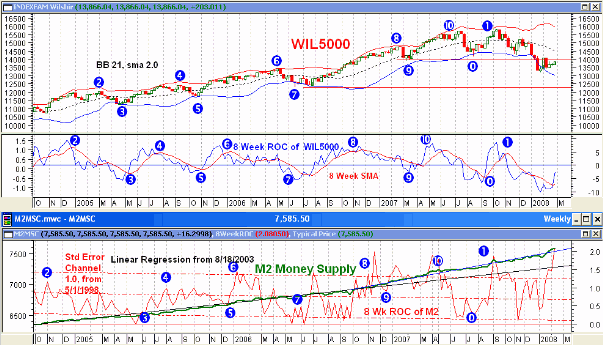
March
For the OTC March has been up 60% of the time with an average return of only 0.1%. The average has been held down by the performance during the 4th year of the Presidential Cycle when it has been up 45% of the time with an average return of -2.2%. About half of the average loss was realized in 1980 then the OTC fell 16.5% for the month.
The charts below show the average daily return for March over all years in blue and for the 4th year of the Presidential Cycle in green.
There are 21 trading days in the average month. The charts have been calculated by averaging the daily return for each of the first 11 trading days and each of the last 10 trading days. In months when there have been more than 21 trading days, some days in the middle of the month have been ignored. In months when there have been less than 21 trading days some days in the middle of the month have been counted twice.
Dashed vertical lines have been drawn after the 1st trading day and at intervals of 5 trading days after that. A solid vertical line has been drawn on the 11th trading day, the dividing point.
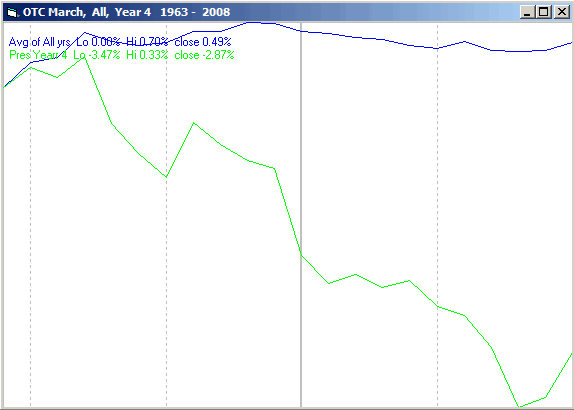
Since 1928 the SPX has been up 60% of the time with an average return of 0.2%. During the 4th year of the Presidential Cycle the performance has been a little better, up 65% of the time with an average return of 0.8%.
The chart below is similar to the one above except it averages daily returns for the SPX. Prior to 1953 the market traded 6 days a week so several days were omitted in the middle of the month during that time.
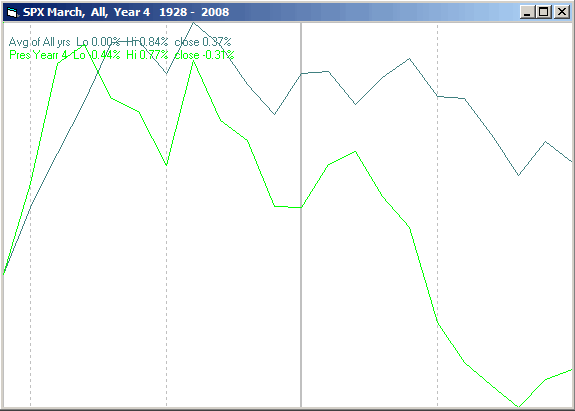
Conclusion
Another rally stalled last week and seasonally, March during the 4th year of the Presidential Cycle, has a spotty record at best.
I expect the major indices to be lower on Friday March 7 than they were on Friday February 29.
By Mike Burk
To subscribe to this report : http://alphaim.net/signup.html
Gordon Harms produces a Power Point for our local timing group. You can get a copy of that at: http://www.stockmarket-ta.com/ .
Disclaimer: Mike Burk is an employee and principal of Alpha Investment Management (Alpha) a registered investment advisor. Charts and figures presented herein are believed to be reliable but we cannot attest to their accuracy. Recent (last 10-15 yrs.) data has been supplied by CSI (csidata.com), FastTrack (fasttrack.net), Quotes Plus (qp2.com) and the Wall Street Journal (wsj.com). Historical data is from Barron's and ISI price books. The views expressed are provided for information purposes only and should not be construed in any way as investment advice. Furthermore, the opinions expressed may change without notice.
Mike Burk Archive |
© 2005-2022 http://www.MarketOracle.co.uk - The Market Oracle is a FREE Daily Financial Markets Analysis & Forecasting online publication.



